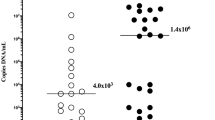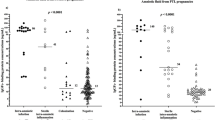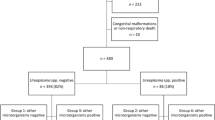Abstract
OBJECTIVE:
To evaluate the correlation of amniotic fluid (AF) markers (AFMs) of intra-amniotic infection with histopathologic findings in cases of preterm labor with intact membranes, between 22 and 36 weeks’ gestation.
STUDY DESIGN:
We reviewed the charts of patients admitted in preterm labor with intact membranes between January 1993 and December 1996. Those having amniocentesis were identified, and AFMs were compared with histopathology in patients who delivered within 48 hours of the amniocentesis. The AFMs evaluated were glucose, polymorphonuclear leukocytes, Gram stain, and culture. All placentae were reviewed by a single pathologist blinded to the AF findings. Histologic evidence of acute inflammation was defined by findings of both subchorial intervillositis and marginating choriodeciduitis. The sensitivities, specificities, and positive and negative predictive values of the various AFMs were calculated.
RESULTS:
Of 556 women with intact membranes presenting in preterm labor, 181 (32.6%) had amniocentesis and 88 delivered within 48 hours of the amniocentesis. Histopathologic chorioamnionitis was seen in 53 patients (60.2%). The findings (with their sensitivity, specificity, and positive and negative predictive values) were: polymorphonuclear leukocytes at >10/high-power field (22.6%, 97.2%, 92.3%, and 46.1%), positive Gram stain (26.4%, 94.6%, 87.5%, and 47.3%), culture (28.3%, 92.1%, 83.3%, and 4 7.9%), and glucose of <15 mg/dl (28.3%, 94.6%, 88.2%, and 47.9%), respectively. Using a receiver-operator characteristic curve for different levels of AF glucose, a glucose level of <20 mg/dl was the most sensitive AF predictor of histologic chorioamnionitis.
CONCLUSION: Histopathologic evidence of chorioamnionitis was present in 60.2% of cases of preterm births due to preterm labor in women who at our institution were offered and accepted amniocentesis and subsequently delivered within 48 hours. AFMs may be useful predictors of histologic chorioamnionitis. The most efficient AFM for chorioamnionitis in this group of patients was glucose at <20 mg/dl.
This is a preview of subscription content, access via your institution
Access options
Subscribe to this journal
Receive 12 print issues and online access
$259.00 per year
only $21.58 per issue
Buy this article
- Purchase on Springer Link
- Instant access to full article PDF
Prices may be subject to local taxes which are calculated during checkout
Similar content being viewed by others
Author information
Authors and Affiliations
Additional information
Presented at the Eighteenth Annual Meeting of the Society of PerinatalObstetricians, Miami Beach, FL, February 2–7, 1998.
Rights and permissions
About this article
Cite this article
Odibo, A., Rodis, J., Sanders, M. et al. Relationship of Amniotic Fluid Markers of Intra-Amniotic Infection With Histopathology in Cases of Preterm Labor With Intact Membranes. J Perinatol 19, 407–412 (1999). https://doi.org/10.1038/sj.jp.7200210
Published:
Issue Date:
DOI: https://doi.org/10.1038/sj.jp.7200210
This article is cited by
-
Immune biomarkers in maternal plasma to identify histologic chorioamnionitis in women with preterm labor
Archives of Gynecology and Obstetrics (2019)
-
Amniotic fluid rapid biomarkers are associated with intra-amniotic infection in preterm pregnancies regardless of the membrane status
Journal of Perinatology (2016)



